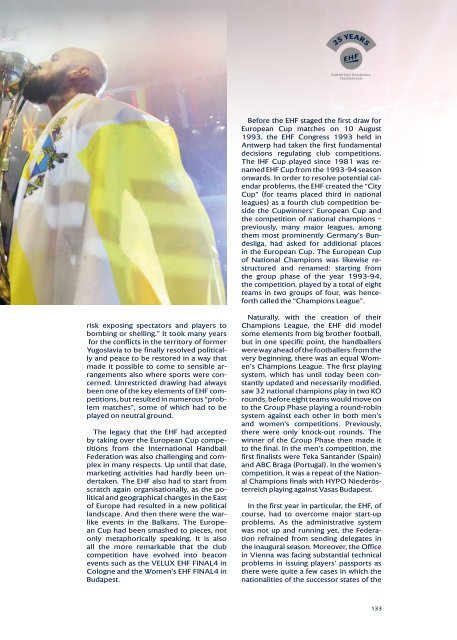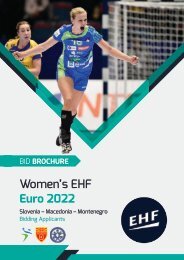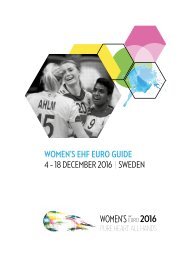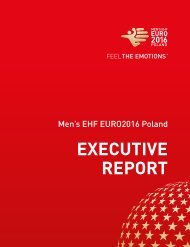ehf_25yers_book_webversion
You also want an ePaper? Increase the reach of your titles
YUMPU automatically turns print PDFs into web optimized ePapers that Google loves.
Before the EHF staged the first draw for<br />
European Cup matches on 10 August<br />
1993, the EHF Congress 1993 held in<br />
Antwerp had taken the first fundamental<br />
decisions regulating club competitions.<br />
The IHF Cup played since 1981 was renamed<br />
EHF Cup from the 1993-94 season<br />
onwards. In order to resolve potential calendar<br />
problems, the EHF created the “City<br />
Cup” (for teams placed third in national<br />
leagues) as a fourth club competition beside<br />
the Cupwinners’ European Cup and<br />
the competition of national champions –<br />
previously, many major leagues, among<br />
them most prominently Germany’s Bundesliga,<br />
had asked for additional places<br />
in the European Cup. The European Cup<br />
of National Champions was likewise restructured<br />
and renamed: starting from<br />
the group phase of the year 1993-94,<br />
the competition, played by a total of eight<br />
teams in two groups of four, was henceforth<br />
called the “Champions League”.<br />
risk exposing spectators and players to<br />
bombing or shelling.” It took many years<br />
for the conflicts in the territory of former<br />
Yugoslavia to be finally resolved politically<br />
and peace to be restored in a way that<br />
made it possible to come to sensible arrangements<br />
also where sports were concerned.<br />
Unrestricted drawing had always<br />
been one of the key elements of EHF competitions,<br />
but resulted in numerous “problem<br />
matches”, some of which had to be<br />
played on neutral ground.<br />
The legacy that the EHF had accepted<br />
by taking over the European Cup competitions<br />
from the International Handball<br />
Federation was also challenging and complex<br />
in many respects. Up until that date,<br />
marketing activities had hardly been undertaken.<br />
The EHF also had to start from<br />
scratch again organisationally, as the political<br />
and geographical changes in the East<br />
of Europe had resulted in a new political<br />
landscape. And then there were the warlike<br />
events in the Balkans. The European<br />
Cup had been smashed to pieces, not<br />
only metaphorically speaking. It is also<br />
all the more remarkable that the club<br />
competition have evolved into beacon<br />
events such as the VELUX EHF FINAL4 in<br />
Cologne and the Women’s EHF FINAL4 in<br />
Budapest.<br />
Naturally, with the creation of their<br />
Champions League, the EHF did model<br />
some elements from big brother football,<br />
but in one specific point, the handballers<br />
were way ahead of the footballers: from the<br />
very beginning, there was an equal Women’s<br />
Champions League. The first playing<br />
system, which has until today been constantly<br />
updated and necessarily modified,<br />
saw 32 national champions play in two KO<br />
rounds, before eight teams would move on<br />
to the Group Phase playing a round-robin<br />
system against each other in both men’s<br />
and women’s competitions. Previously,<br />
there were only knock-out rounds. The<br />
winner of the Group Phase then made it<br />
to the final. In the men’s competition, the<br />
first finalists were Teka Santander (Spain)<br />
and ABC Braga (Portugal). In the women’s<br />
competition, it was a repeat of the National<br />
Champions finals with HYPO Niederösterreich<br />
playing against Vasas Budapest.<br />
In the first year in particular, the EHF, of<br />
course, had to overcome major start-up<br />
problems. As the administrative system<br />
was not up and running yet, the Federation<br />
refrained from sending delegates in<br />
the inaugural season. Moreover, the Office<br />
in Vienna was facing substantial technical<br />
problems in issuing players’ passports as<br />
there were quite a few cases in which the<br />
nationalities of the successor states of the<br />
133














